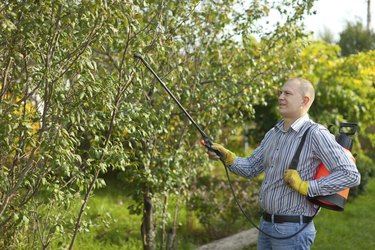
If you're a gardener seeking an organic treatment for fungal diseases and insect infestations, consider lime-sulfur concentrate. With careful handling, lime sulfur controls or prevents powdery mildew, scab, anthracnose, peach leaf curl and other common fungal diseases on a host of ornamental and edible plants. As a pesticide, it eliminates scale insects, mites and thrips. Never use lime sulfur, however, without protection from its corrosive alkalinity and the toxic fumes it releases when mixed with acid.
The Right Ratio
Video of the Day
Proper use of lime sulfur includes mixing the correct ratio of concentrate to water for the specific plant, problem and time of year. One manufacturer, for instance, recommends spraying in spring with a mixture or of 7 tablespoons of concentrate per 1 gallon of water to prevent powdery mildew on apple trees (Malus spp.), hardy in U.S. Department of Agriculture plant hardiness zones 3 through 9. To treat summer outbreaks of black spot, powdery mildew or red spider mites on roses (Rosa spp.) in USDA zones 2 through 10, however, the same manufacturer recommends 1 tablespoon of concentrate per gallon of water applied every 10 to 15 days. Other lime sulfur brands may require different ratios. Successful treatment depends on applying your product according to its label's specifications.
Video of the Day
Before You Begin
Applying lime sulfur in hot, dry conditions may burn your plants. Wait until the temperature is between 33 and 75 degrees Fahrenheit and no rain or strong wind is in the 24-hour forecast. Plants intolerant of lime sulfur include apricot trees (Prunus armeniaca), suitable for U.S. Department of Agriculture plant hardiness zones 5 through 7; rhododendrons (Rhododendron spp.), found in USDA zones 2 through 9; burning bushes (Euonymus alatus) and other euonymus species plants in USDA zones 3 through 9 and all evergreens. Cover them and any concrete or painted surfaces within range of the drifting spray.
Mixing and Spraying
Before opening the concentrate, dress in a washable long-sleeved shirt, long pants, socks and waterproof, chemical-resistant shoes and gloves, a hat, safety goggles and a respiratory mask. After pouring one-quarter of the label's recommended amount of water to a clean hose-end, tank or hand sprayer, add the suitable amount of lime sulfur, agitate the container to mix the solution and add the remaining water. With the wind to your back, spray until you've covered the plants thoroughly.
The Cleanup
Empty and rinse your sprayer on the soil around the treated plants before removing and wash your clothes, face mask and goggles. Don't drink, eat or smoke without washing your hands. Avoid the sprayed area until the plants dry. If you must enter it, put the protective clothing and gear back on.
Potential Problems
Some products don't mix safely with lime sulfur. Adding copper soap fungicide to it renders both products ineffective. Spraying lime sulfur on leafed-out plants within two weeks of treating them with horticultural oil may damage their foliage. Potentially deadly hydrogen sulfide gas may result from mixing alkaline lime sulfur with acidic products, including some household cleansers or horticultural vinegar used to kill weeds.
- University of Nebraska-Lincoln Lancaster County Extension: Lime-Sulfur -- a Fungicide Used to Control a Variety of Diseases
- University of Illinois Extension Hortanswers: Apple
- David Austen Roses: Climate Information
- University of Delaware Extension: Kent County Agriculture: Delayed Dormant Sprays on Small Fruits
- ZipcodeZoo.com: Prunus Armeniaca (Apricot)
- Oregon Department of Agriculture: Fact Sheet for Vinegar/Acetic Acid Recommendations
- U.S. Department of Health and Human Services: Household Products Database: Chemical Information – Hydroxyacetic Acid
- Today's Homeowner: Protect Trees and Shrubs with Dormant Sprays